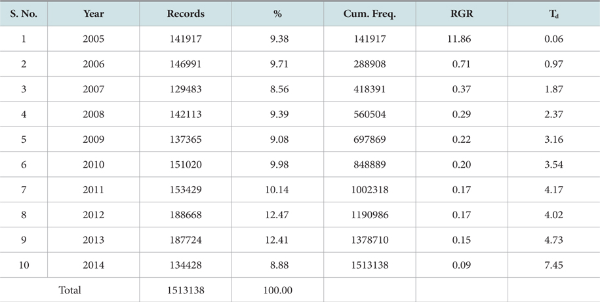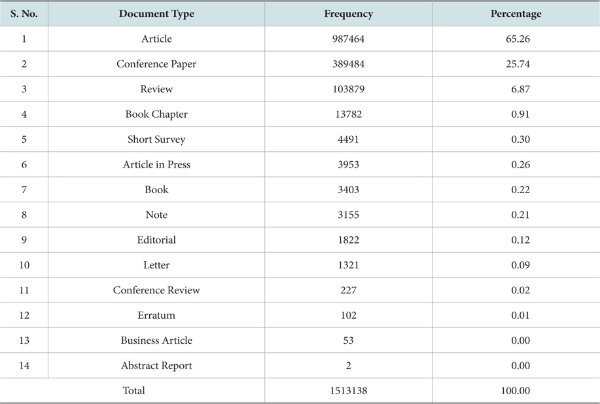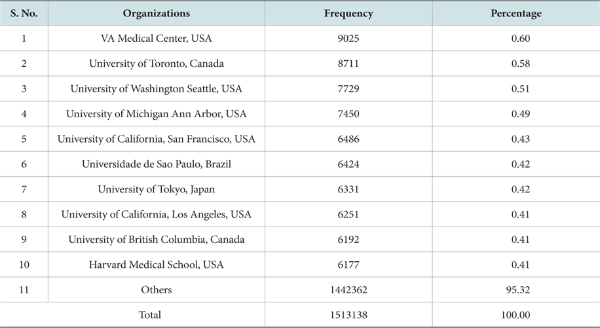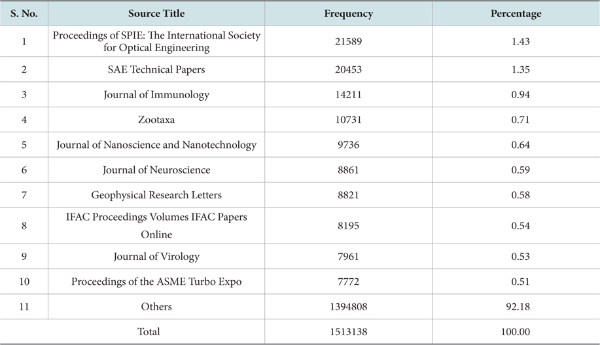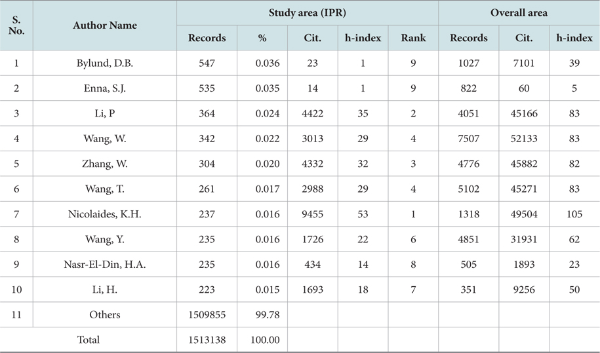ISSN : 2287-9099
Scientometrics Profile of Global Intellectual Property Rights Research

S. Balamurugan (GITAM University Bengaluru Campus)

Abstract
The authors in this paper aim to identify the growth of literature on Intellectual Property Rights (IPRs). The research publications on IPRs were downloaded from the Scopus online citation database and the authors found that there were 1,513,138 records contributed globally over a period of 10 years from 2005 to 2014. The distribution of publications based on the year, country, and document type were studied. Relative growth rate (RGR) of the publications and doubling time (Td) were calculated. Most productive organizations, source titles, and the productive authors on IPR research were studied. Most cited articles in the study area were identified. The results show that a number of publications under the subjects Medicine and Engineering were produced. The developed countries are very active in IPR research and producing publications. It is found that one institution which holds the sixth place among the top 10 most productive institutions belongs to Brazil, a developing country. Two developing countries such as China and India hold second and tenth positions respectively in the top 10 countries contributing literature on IPRs.
- keywords
- Intellectual Property Rights, IPR, Copyright, Patent, Trademarks, Industrial Design, Geographical Indications, Layout-Design, Trade Secrets, Bibliometrics, Scientometrics
1. INTRODUCTION
Intellectual property (IP) refers to the creations and innovative ideas of human intellectuals in both artistic and commercial fields for which the creators are given exclusive rights (Raysman et al., 2011). According to the World Intellectual Property Organization (WIPO) and World Trade Organization (WTO), IPs are divided into two categories, namely literary property and industrial property. The copyright is the right of the authors for their literary works such as novels, poems, films, musical works, drawings, paintings, photographs, sculptures, plays, computer programs, databases, advertisements, maps and architectural designs, and neighboring rights for performance and broadcasting. The industrial property includes patents of inventions, trademarks, industrial designs, and geographical indications. The patent gives exclusive rights to the patent owner to decide how/whether his/her new useful and non-obvious innovation and invention can be used by others. The trademarks protect signs like logos, symbols, and brands used to distinguish goods or services in the market; industrial designs acts give rights to a manufacturer for the visual patterns or structures, two/three dimensional features, lines, and colors applied to their product; geographical indications are signs used on the goods for their geographic origin which attributes in the quality and characteristics of the goods; layout designs of integrated circuits gives protection from knowingly/unknowingly infringing integrated circuits; and undisclosed information (trade secrets) protect innovation or know how. Creators are given protection for their IPs, except for the trademark, which gets a right to renew unlimited times, for a limited period of time defined by the respective laws.
Many legal principles have evolved over centuries in governing IPs. It was from the 19th century that the term ‘intellectual property’ was used but in the late 20th century it became more popular (Lemley, 2005). Even though the term was not then very popular, authors, creators, and their assigns were granted the sole right and liberty in printing books by the British Statute of Anne (1710) for 14 years (Cornish, 1996) which made other countries think about the rights of the creators. This statute is considered as the origin of copyright and the Statute of Monopolies (1623) is considered as the origin of patent law (Sherman & Bently, 1999).
Research plays a vital role in measuring the development of any country and research literature output is the benchmark for measuring socio-economic status. A survey of the research trends is felt necessarily desirable, during the last few years, to get knowledge about research performance. Scientometric analysis has now been increasingly used for evaluating the research performance of the leading scientists, institutions, and the growth of various disciplines of science. Scientometrics is the quantitative study for measuring and analyzing the science, technology, and innovation which includes all quantitative aspects of science, communication, and policies in terms of science (Wilson, 2001).
2. REVIEW OF PRIOR STUDIES
The long-term economic growth of any country depends on the development of research activities. Realizing this fact, both public and corporate organizations are spending enormous amounts of money, time, and resources on research and development (Ocholla & Onyancha, 2006) and most of the countries are tightening IPR protection (Woo, Jang, & Kim, 2015). The patent is one of the most used indicators to assess the growth of science and technology in a given geographical area. For determining the potentials of higher education institutions, universities, and research centers it is important to examine the numbers of patents they have applied for and/or received. Noruzi and Abdekhoda (2012) examined the patents registered in Iran and found that registering for patents is an increasing trend. Joydipta et al. (2016) studied the trends of research outputs and patents on metallic fuel development for fast reactors using INIS, INSPEC, Web of Science, and Scopus databases and have witnessed the upsurge of publications in recent years. Terekhov (2015) studied the scientific publications and patents in the field of carbon nanostructures in Russia using Science Citation Index (SCI), United States Patent and Trade Office (USPTO), and the World Intellectual Property Organization (WIPO) and compared the publication growth and quality of research of Russia with other countries.
Prathap (2014) used SCImago Institutions Ranking World Reports 2013 to evaluate the performance of institutions in India based on the quality and quantity of research outputs during 2003-2011 and reveals that there is a reasonable growth rate in output but only a few institutions show improvement in the quality of research. Senel and Demir (2015) studied the growth of telemedicine and teledermatology literature using Web of Science and Li, Hu, and Ho (2014) investigated the performance and research trend of quantitative structure-activity relationships (QSAR) and quantitative structure-property relationship (QSPR) using SCI Expanded database, and reveal from their study that developed countries have contributed more in the respective fields and are also more influential in citation, whereas the countries which are economically developing were higher in output rates. Kolesnykova and Matveyeva (2015) studied the research performance in railway transport using Scopus and Science Direct databases. There were similar studies on climate change with 94,756 records contributed worldwide for the period of 1999-2012 (Venkatesan, Gopalakrishnan, & Gnanasekaran, 2013) and genetic engineering with 165,984 records contributed worldwide from 1974- 2003 (Balasubramani, Gopalakrishnan, & Gnanasekaran, 2014). The research outputs published in the Journal of Intellectual Property Rights (JIPR) during 2007-2012 was investigated by Velmurugan (2013) and the outputs during 1996-2012 were investigated by Garg and Anjana (2014). Both of these studies concentrated on the authorship pattern, author’s productivity and average citations, prolific institutions, distribution of literature among the countries, and so on.
Even though there is a vast amount of published information available in the field of IPR there are more scientometrics studies conducted for various subjects that do not have concentrated world output on IPRs. Hence, the authors in this study aim to capture the overall IPR research output, which is emerging as a burning topic today, on several parameters including its growth and share in the global research output, research communication pattern in core journals, geographical distribution of publications, share of internal collaborative publications, in various subjects, at the national level, and by research performance of the scientists and various institutions. A scientometric analysis was employed to study the growth of literature in this field.
3. OBJECTIVES
The main objective of the analysis on the publications searched from Scopus citation database is to identify the 10 years’ (2005-2014) global research trend in IPR with the aim to:
-
• study year wise research trend on IPR
-
• study the growth rate of the publications on IPR
-
• identify the contribution of most productive countries related to IPR
-
• identify the bibliographic forms
-
• identify the contribution of most prolific organizations
-
• identify the contribution of most productive source titles
-
• study the highly prolific authors in the field of study
-
• identify the most cited articles
4. METHODOLOGY
The current study focused on the global research literature on IPR retrieved from the Scopus citation database for the period of 10 years from 2005 to 2014. The database was searched for retrieving literature published in peer-reviewed journals and other bibliographic types. The Scopus database was chosen to retrieve the publications since it covers large numbers of literature in different domains such as Science, Technology, Medical, Engineering, Management, and Arts & Humanities.
The following strings were used to retrieve data on IPR from Scopus database:
((TITLE-ABS-KEY("Intellectual Property Right" or "Intellectual Property Rights" or "IPR" or "IPRs" or "copyright" or "copyrights" or "trademark" or "trademarks" or "patent" or "patents" or "industrial design act" or "industrial designs act") OR TITLE-ABS-KEY("geographical indications" or "Integrated Circuits Layout Design Act" or "Integrated Circuits Layout Designs Act" or "Integrated Circuits Layout-Design Act" or "Integrated Circuits Layout-Designs Act" or "IC Layout Design Act" or "IC Layout Designs Act") OR TITLE-ABS-KEY("IC Layout-Design Act" or "IC Layout-Designs Act" or "ICs Layout Design Act" or "ICs Layout Designs Act" or "ICs Layout Design Act" or "ICs Layout-Designs Act")) AND PUBYEAR > 2004 AND PUBYEAR < 2015)
A total of 1,513,138 records were identified in the field of IPR worldwide during the period of 10 years from 2005-2014. Various indicators such as global research trends on IPR, country wise and year wise distribution, bibliographic form, and most productive organizations, journals, and authors of the publications are provided in this paper.
Statistical tools such as frequency distribution, percentage analysis, and Bibliometric techniques such as Relative Growth Rate (RGR), Doubling time (Td), citation analysis, and h-index were used for the study
5. RESULTS
5.1. Growth of Publications on IPR during 2005-2014
Using this 10 years’ literature retrieved from the Scopus database, the researchers find that there were 1,513,138 instances of literature available during the study period and the same is presented in Table 1. For finding the increase in a number of articles per unit of time, Relative Growth Rate (RGR) was calculated using the following equation.

where
-
 = mean relative growth rate over the specific period of interval
= mean relative growth rate over the specific period of interval
-
loge 1W = natural log of the initial number of publications
-
loge 2W = natural log of the final number of publications after a specific period of interval
-
2T - 1T = the unit difference between the initial time and the final time (The year is taken here as the unit of time).
According to Mahapatra (1985), there exists a direct equivalence between the relative growth rate and the doubling time. If the number of articles of a subject doubles during a given period then the difference between the logarithms of numbers at the final time and the initial time of this period must be equivalent to the logarithms of number 2. If natural logarithm is used this difference has a value of 0.693. Thus, the corresponding doubling time (Td) of articles for each specific period of the interval is arrived at by dividing 0.693 by mean RGR.
We can see from Table 1 and Fig. 1 that there are ups and downs in the contribution of literature during the study period and there is a decreasing trend in the rate of growth. In the year 2012, the highest numbers of publications (188,668; 12.4%) were published. During the years 2007 and 2014, it is recorded that the least numbers of contributions were made. In general, there is no growth in the research output on IPR globally during the past 10 years.
5.2. Most Productive Countries in IPR Research Output
The total of 1,513,138 publications on IPR retrieved from the Scopus database were contributed by more than 150 countries and their global share varied from 36.50% to 0.002% over the 10 years from 2005 to 2014. Among them, the top 10 countries based on their production are given in Table 2.
Table 2.
Country wise Distribution of Research Output on IPR
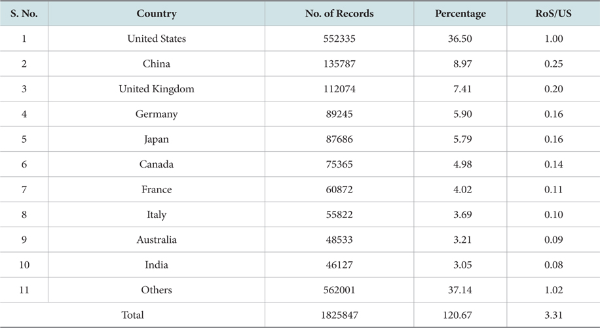
RoS – Rate of Share compared with the USA
The global share of 83.52% (1,263,846) of the total publications on IPR was contributed by the top 10 countries with their publications share ranging from 36.50% to 3.05%. The United States dominated with 36.50% (552,335) of the total publications and holds first place. China (8.97%) and the United Kingdom (7.41%) occupy second and third places respectively. India holds tenth place with the share of 3.05% (46,127) of the publications.
The rate of share for publications by the ten most productive countries were compared with the rate of share of the USA. China holds 0.25% and UK 0.20%. India holds 0.08%.
5.3. Source Types and Bibliographic Forms of Publications on IPR
The literature taken for this study appeared in six types of sources such as journals, conference proceedings, book series, books, trade publications, and reports. Also, it was found that 14 different types of bibliographic form carry the total publications.
Among the six types of publications, journals are the dominant carrier of the publications (81.08%) followed by conference proceedings (16.99%). Book series and books collectively hold 1.5% of the publications. 0.43% of the publications appeared in trade publications.
Table 3 shows the 14 document types which carry the total publications. Out of them, articles (65.26%) dominated with 987,464 publications followed by conference papers (25.74%) and reviews (6.87%). Less than 3.00% of the total publications appeared in other document types.
5.4. Most Productive Organizations on IPR
It is found that more than 200 organizations have contributed to the total publications taken for this study. Out of them, the top 10 most productive organizations are listed in Table 4.
The ten most productive organizations have collectively produced 4.68% of the total literature. They have contributed literature ranging from 9,025 to 6,177 in number. Each of these institutions individually produced more than 6,000 publications during the study period of 10 years from 2005 to 2014. VA Medical Center, USA has produced 9,025 publications (0.60%) which is followed by the University of Toronto, Canada with 8,711 (0.58%) and the University of Washington Seattle, USA with 7,729 (0.51%) publications.
Nine institutions among the top 10 institutions contributed in IPR research belong to developed countries such as the USA (6), Canada (2), and Japan (1). It is to be noted that one institution is from Brazil, one of the developing countries.
5.5. Most Productive Source Titles
The top 10 most productive source titles have collectively contributed 118,330 literature publications during the study period which accounts for a 7.82% share of the total global contributions. These 10 source titles are listed in Table 5.
Proceedings of SPIE: The International Society for Optical Engineering has topped with 21,589 (1.43%) contributions followed by SAE Technical Papers, which contributed 20,453 (1.35%), and the Journal of Immunology with 14,211 (0.94%) contributions. They hold first, second, and third places respectively based on the production of literature.
5.6. Subject Area of the Publications on IPR
The 10 most influential subjects in IPR research are listed in Table 6. These subjects collectively contributed 1,776,029 publications which indicates more than 60% of the literature published in more than one subject.
Among these subjects, Medicine holds the top place with 465,836 (30.79%) contributions, followed by Engineering contributing 326,969 (21.61%) and Computer Science with 187,065 (12.36%) publications.
5.7. Most Productive Authors
The ten most productive authors together contributed 3,283 publications on IPR which accounts for a 0.224% share of total global publications with an average of 328.3 papers per author. The top ten most productive authors are listed in Table 7.
Among the 10 most productive authors, four authors have contributed more than the group average (328.30). D. B. Bylund has produced 547 (0.036%) papers and is top-ranked, followed by S.J. Enna (535; 0.035%), P. Li (364; 0.024%), and W. Wang (342; 0.022%). The top two authors, based on the number of records, D. B. Bylund and S. J. Enna, have jointly published 522 records and have no citation. But individually both of them have 1 h-index values for their publications in the study area. They hold the least position in the rank assigned based on h-index. D. B. Bylund has 39 h-index value and S. J. Enna has 5 h-index value individually for their publications in overall subject areas.
Even though K. H. Nicolaides is in seventh place based on the number of publications produced in the study area, Nicolaides holds first place with 53 h-index (237 publications with 9,455 citations), followed by P. Li with 35 h-index and W. Zhang with 32 h-index. Nicolaide has 105 h-index with 49,504 citations for 1,318 publications in overall subject areas, and has consistency in gaining the citations to his publications from both study area (53 h-index) as well as overall area (105 h-index), and holds the first position based on the h-index.
5.8. Highly Cited Publications
For the purpose of identifying the most cited publication, an analysis was carried out based on citations and the details are presented in Table 8. The top 10 highly cited publications were identified and ranked based on average citation per year. Among them, four publications were published in the New England Journal of Medicine. The other publications are CA Cancer Journal for Clinicians, Behavior Research Methods, Journal of the American Chemical Society, and International Journal of Climatology.
The article “Cancer statistics, 2012,” published in the CA Cancer Journal for Clinicians by Siegel, Naishadham, and Jemal in the year 2012 has been cited 5,873 times, which holds first place. Even though this article has the highest citation it holds second place based on the average citations per year (1957.66 citations per year). The article “Cancer statistics, 2013” published by these same authors in the same journal in the year 2013 holds the first place with 2,215 average citations per year.
6. FINDINGS
Based on the results obtained from the data collected on various IPRs, the authors derive the following findings.
• A total of 1,513,138 publications were produced on IPRs during the study period, i.e. 2005-2014, and these publications were contributed by more than 150 countries.
• Even though huge numbers of publications appeared on IPRs there were ups and downs in the growth of literature over a period of time. The doubling time for publications is gradually increasing which means the rate of relative growth shows a declining trend.
• It is learned from Table 2 that about 20.67% of research publications were produced by collaboration with other countries. The global share of 83.52% (1,263,846) was contributed by the top 10 countries such as the United States of America, China, United Kingdom, Germany, Japan, Canada, France, Italy, Australia, and India. Eight countries among these are developed countries and they have contributed more publications.
• Top prolific organizations contributing to IPR research belong to developed countries. Among the top 10 prolific organizations, six institutions are from the USA, and two institutions are from Canada, with one each from Japan and Brazil. Even though the developing countries China and India have contributed more literature and they are among the top 10 contributing countries no organization from these countries finds a place in the top 10 prolific organizations.
• The leading subjects contributing to the IPR literature are medicine, engineering, computer science, life sciences, and natural sciences. But most of the literature are published in engineering and life science journals. It seems that more than 60% of the literature are multidisciplinary in nature.
• It seems that no positive relationship exists between the number of publications and citations received. Based on the numbers of publications, D. B. Bylund (547; 0.036%) and S. J. Enna (535; 0.024%) are the top two contributors in IPR but they both individually have 1 h-index value for their publications in the study area and hold the ninth position based on h-index ranking. They have more citations in other subject areas which show no consistency among these two authors in getting citations to their publications.
• The articles “Cancer statistics, 2012” and “Cancer statistics, 2013” published in the CA Cancer Journal for Clinicians by Siegel, Naishadham, and Jemal are the top two based on average citations per year. Even though “Cancer statistics, 2012” has more citations than “Cancer statistics, 2013,” the latter holds the highest average citations per year. This might have happened since these two publications are basically bringing out cancer statistics. It is a common knowledge that citations to the current statistics may be higher than for the older ones.
7. SUGGESTIONS
From the results of the collected data, findings, and observations, the authors have formulated the following suggestions.
• The patent is one of the most used indicators to assess the growth of science and technology in a given geographical area. It is understood from the review of previous studies and collected data that most of the studies concentrated on patents and very few studies are available for other areas of IPRs. Global efforts should be put on the other areas of IPRs.
• We have seen in this study that there is a declining trend in the relative growth rate. The institutions and research centers should self-examine themselves to identify the reasons behind the low publication growth in both quantity and quality aspects.
• The study shows that developed countries are always dominant in research output in almost all fields. The very common knowledge is that the number of publications shows the amount of research carried out in any country. The higher educational institutions, research centers, and universities in developing and under-developed countries may set up an IPR cell, technology transfer offices, and so on to encourage research in the field. Developed countries should encourage the poorest nations and extend their support for research collaboration and funding since there may be an absence of scientific communities to encourage the research. Although there are different IRP regimes, policies, and different institutional settings among countries they should come forward for attaining parallel growth. This may bridge the gap in IPR research between developed and developing/under-developed nations.
• The growth of long-term economies relies on the protection of new ideas and investment in technological innovation. Hence, the apex bodies for higher education and funding agencies, in any country, should stimulate institutions and research centers in these kinds of research and put more attention on innovation, quality research, use, and effectiveness of IPRs. They should try to simplify procedures in funding and help inventors and creators disseminate their innovations and creative products globally.
8. CONCLUSION
Since it is the need of the day, an effort was made by the authors for analyzing the collected data on IPR and applying bibliometric indicators. Large numbers of literature were produced on IPR during the study period. Even though IPR is a very hot topic today, the growth rate is not linear in nature. The authors have found that there was no steady growth in publication production and the rate of growth is in a declining trend. Developed countries are most active in producing publications and it seems that most of the developing countries are not active in IPR research. Only China and India among developing countries hold second and tenth positions, respectively, in the top ten countries list based on publication production. Developing and under-developed countries are severely affected by IPR issues and this may be the reason behind the low production of publications. Hence, more attention is to be taken by the developing countries in IPR issues and the respective governments have to make necessary arrangements for regulatory oversight for IPR and related issues.
References
On the validity of the theory of exponential growth of scientific literature((1985)) Proceedings of the 15th IASLIC Conference, Bangalore Mahapatra, M. (1985). On the validity of the theory of exponential growth of scientific literature. In Proceedings of the 15th IASLIC Conference (pp. 61-70). Bangalore. , MahapatraM., 61-70
((2013)) Research trends in Journal of Intellectual Property Rights (JIPR): A bibliomentric study Library Philosophy and Practice http://digitalcommons.unl.edu/libphilprac/1043.
Annual review of information science and technology (, ) ((2001)) Medford NJ: Information Today, Inc. for the American Society for Information Science Wilson, C. S. (2001). Informetrics. In M. E. Williams (Ed.), Annual review of information science and technology, vol. 3 (pp. 143). Medford NJ: Information Today, Inc. for the American Society for Information Science. , p. 143, Informetrics
World Intellectual Property Organization ((2004)) WIPO intellectual property handbook: Policy, law and use World Intellectual Property Organization (2004). WIPO intellectual property handbook: Policy, law and use. Retrieved from http://www.wipo.int/export/sites/www/about-ip/en/iprm/pdf/ch1.pdf , Retrieved from http://www.wipo.int/export/sites/www/about-ip/en/iprm/pdf/ch1.pdf
World Trade Organization (n.d.)What are intellectual property rights? World Trade Organization (n.d.). What are intellectual property rights? Retrieved from https://www.wto.org/english/tratop_e/trips_e/intel1_e.htm. , Retrieved from https://www.wto.org/english/tratop_e/trips_e/intel1_e.htm
- Submission Date
- 2015-11-16
- Revised Date
- Accepted Date
- 2016-04-28


